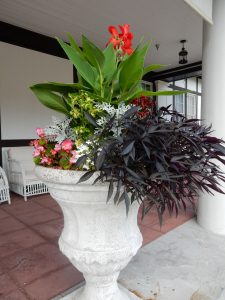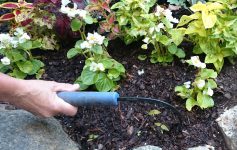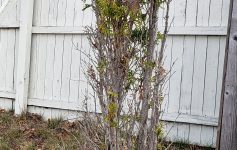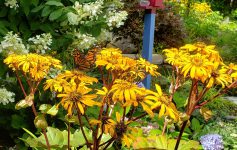 The tropical cana plants are a beautiful addition to our landscapes and containers. I use them as a “thriller” element in my containers and a center focal in many of my annual displays. In our region, the cana display lining the center island of Union Avenue in Saratoga Springs is a traditional sign of the forthcoming race track season. Their broad thick leaves, gorgeous colored/textured blooms make for a striking compliment to gardens. The red cana are a predominant choice in our area, however I have used yellow and pink to compliment my garden color schemes. If you are looking for a full sun 6+ foot plant that attracts the pollinators, this is your plant. Choose the red flowering variety to attract the hummingbirds to your gardens.
The tropical cana plants are a beautiful addition to our landscapes and containers. I use them as a “thriller” element in my containers and a center focal in many of my annual displays. In our region, the cana display lining the center island of Union Avenue in Saratoga Springs is a traditional sign of the forthcoming race track season. Their broad thick leaves, gorgeous colored/textured blooms make for a striking compliment to gardens. The red cana are a predominant choice in our area, however I have used yellow and pink to compliment my garden color schemes. If you are looking for a full sun 6+ foot plant that attracts the pollinators, this is your plant. Choose the red flowering variety to attract the hummingbirds to your gardens.
When generating your annual displays, the potted cana plant may be one of the pricier ones in your design. So I gave some thought to learning how to winterize the bulbs and reuse for next year. I had the good luck to start up a cana bulb dialog with Tom who lives out in the Saratoga Lake area. Tom informed me, he has made it a annual commitment, winterizing his cana bulbs. In fact he has had such success, many of the bulbs now in his garden originated from his wife’s family property down south. With his process, Tom says he has bulbs to reuse in his gardens each year, as well as donate extras to the annual Saratoga Springs New England Congregational Church Fall Rummage Sale.
So this year I took Tom’s expert advice and added it to my fall garden practices. I began my own system for winterizing my cana bulbs. Here are some tips from Tom and my experiences this season:
- Once your garden season has faded, and we have experienced our first light frost, dig up the bulbs and cut off the foliage. You will find the bulbs have grown remarkably. I used a spade shovel with adequate leverage to dig mine.
- Knock off the soil around the bulbs. You will find the single bulb you planted, has now morphed into multiples. Make sure you get as much soil as possible off the bulbs.
- Thoroughly dry out bulbs before attempting to store. A few days in the sun after soil removal will help this.
- Once free of moisture, you can store the bulbs. I line an open cardboard box with newspaper for this. I tend to stay away from plastic containers, they may create moisture you do not want during your storage months.
- Once in your dry container, store the bulbs in a dry place for the winter, a garage or basement, 40-60 degree temperatures are optimum.
- Start your plantings early spring in containers in a protected area or in the ground after the last spring frost. I use a 3-3-3 fertilize when planting to jump start plant growth. Choose a full sun, well drained site and plan to water and fertilize routinely. An organic mulch top dress provides season long protection and adds nutrients. I prefer a granular plant fertilizer once a month throughout the growing season for a nice slow release.
A little bit of time and effort with your cana bulbs now, will add a sustainable element to your annual displays. And like Tom, sharing your bulbs with family, friends and the community, extends that sustainability concept to those we care about.
As always….keeping common sense and sustainability at the root of my garden practices!



